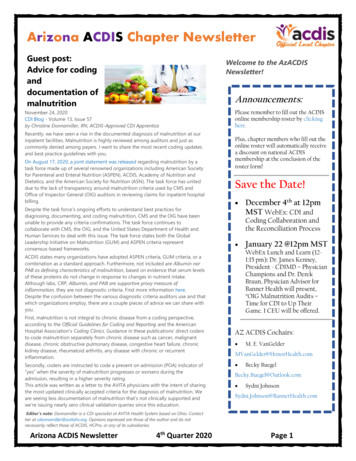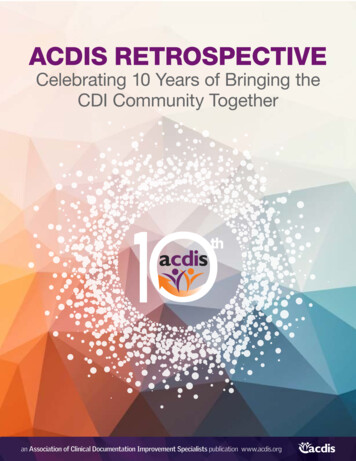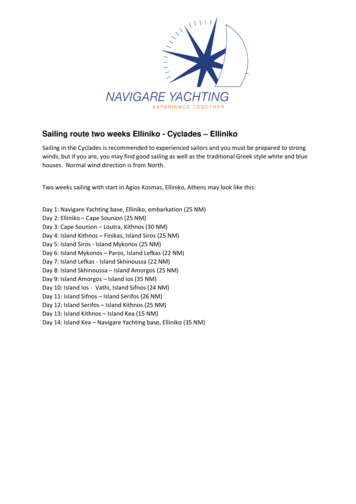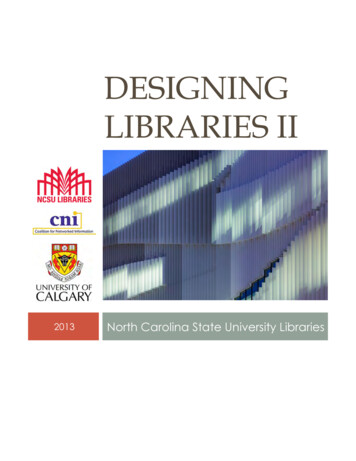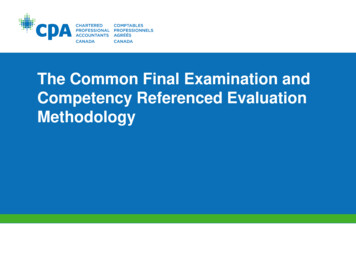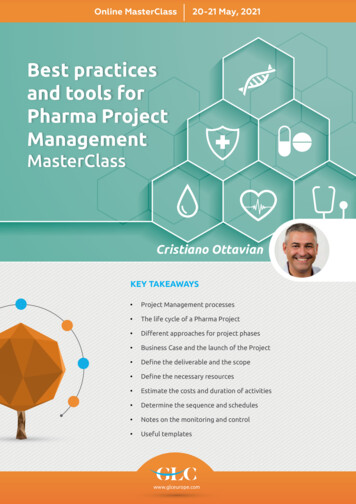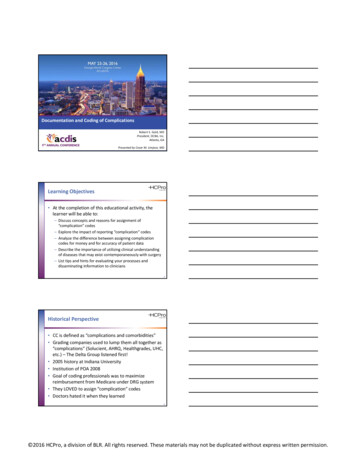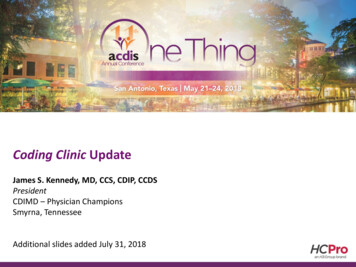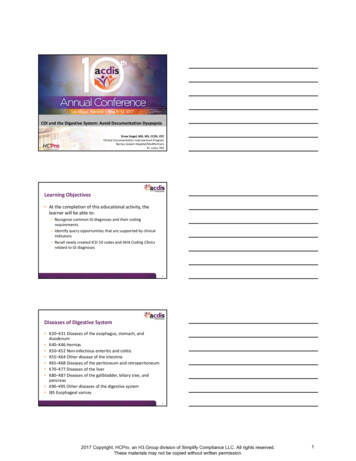
Transcription
CDI and the Digestive System: Avoid Documentation DyspepsiaDrew Siegel, MD, MS, CCDS, CPCClinical Documentation Improvement ProgramBarnes‐Jewish Hospital/MedPartnersSt. Louis, MO1Learning Objectives At the completion of this educational activity, thelearner will be able to:– Recognize common GI diagnoses and their codingrequirements– Identify query opportunities that are supported by clinicalindicators– Recall newly created ICD‐10 codes and AHA Coding Clinicsrelated to GI diagnoses2Diseases of Digestive System K20–K31 Diseases of the esophagus, stomach, andduodenum K40–K46 Hernias K50–K52 Non‐infectious enteritis and colitis K55–K64 Other disease of the intestine K65–K68 Diseases of the peritoneum and retroperitoneum K70–K77 Diseases of the liver K80–K87 Diseases of the gallbladder, biliary tree, andpancreas K90–K95 Other diseases of the digestive system I85 Esophageal varices32017 Copyright, HCPro, an H3.Group division of Simplify Compliance LLC. All rights reserved.These materials may not be copied without written permission.1
Gastroesophageal Reflux Disease (GERD) Gastroesophageal reflux disease– With esophagitis (K21.0)– Without esophagitis (K21.9) Erosive esophagitis, ulcerative esophagitis– Without bleeding (K22.10)– With bleeding (K22.11)4Other Diseases of the Esophagus Barrett’s esophagus (K22.7XX) Eosinophilic esophagitis(K20.0) Candida esophagitis (B37.81) Esophageal ulcer due tomedication (K22.1X andT509.05A) orpoisoning/suicide attempts Strictures/stenosis (K22.2)Eosinophilic esophagitis https://commons.wikimedia.org/wiki/File:Multi ring esophagus.jpgEsophagitis with stricture https://commons.wikimedia.org/wiki/File:Peptic stricture.pngEosinophilic EsophagitisErosive esophagitis with stricture5Ulcers of the Esophagus Query opportunities– Bleeding Establish causal relationship with endoscopic finding– Acute blood loss anemia– Nutritional diagnosis62017 Copyright, HCPro, an H3.Group division of Simplify Compliance LLC. All rights reserved.These materials may not be copied without written permission.2
Mallory‐Weiss Tear (K22.6) Gastroesophageal laceration—hemorrhagic 0%93Weiss syndrome#/media/File:Mallory Weiss Tear.tif7Esophageal Perforation (non‐traumatic)(K22.3) Boerhaave’s syndrome– “The patient ate a meal that included vealsoup, cabbage boiled with mutton, calfsweetbreads, spinach, duck, two larks, applecompote, bread, and beer”– Several hours later patient vomited forcefully,ruptured his esophagus, and died in agonydays laterBy J. Chapman, https://commons.wikimedia.org/w/index.php?curid 67076038Esophageal Varices (I85.XX) Types:– Primary/idiopathic Uncommon Not bleeding (I85.00) With bleeding (I85.01)– Secondary Most common type– Cirrhosis of the liver– Alcoholic liver disease– Schistosomiasis (rare in U.S.) Code the underlying cause first (principaldiagnosis)92017 Copyright, HCPro, an H3.Group division of Simplify Compliance LLC. All rights reserved.These materials may not be copied without written permission.3
Secondary Esophageal Varices Without bleeding (I85.10)Fig. 1 With bleeding (I85.11)Fig. 2Fig. 1: https://commons.wikimedia.org/wiki/File:Esophageal varices ‐ wale.jpgFig. 2: https://en.wikipedia.org/wiki/File:Esophageal varices being banded, showing white ball sign and wale sign.jpg10Esophageal Varices Query opportunities––––Underlying cause (code first)Link the diagnosis with the bleedingHypovolemic shockABLA11Gastric and Duodenal Ulcers Gastric ulcers (K25.X)– Includes gastric erosions, stomach and pyloric ulcers Duodenal ulcers (K26.X)– Includes duodenal erosions, postpyloric ulcer Gastrojejunal ulcers (K28.X)– Marginal, anastomotic122017 Copyright, HCPro, an H3.Group division of Simplify Compliance LLC. All rights reserved.These materials may not be copied without written permission.4
Gastric and Duodenal Ulcers Acute, chronic (default)HemorrhagePerforationBoth hemorrhage and perforationExamples: Gastric ulcer with hemorrhage (K25.4) Acute duodenal ulcer with perforation (K26.1)13Bleeding Gastric ing gastric ulcer.png14Gastrointestinal HemorrhagePatient is admitted with hematemesis.Upper endoscopy report:– Duodenal ulcer, no active bleeding present. A clip wasplaced on a visible vessel.https://en.wikipedia.org/wiki/Upper gastrointestinal bleeding#/media/File:DU 2.jpghttps://en.wikipedia.org/wiki/Upper gastrointestinal bleeding#/media/File:GU with clip.jpg152017 Copyright, HCPro, an H3.Group division of Simplify Compliance LLC. All rights reserved.These materials may not be copied without written permission.5
GI Bleed GI bleeding with multiple possible sources (AHA Coding Clinic,Third Quarter 2005, pp. 17–18) GI bleeding with a single finding (AHA Coding Clinic, SecondQuarter 2007, p. 13)– The coder should not assume a causal relationship betweengastrointestinal bleeding and single finding. The physician mustidentify the source of bleeding and link the clinical findings, asthese findings may be unrelated to the bleeding. If cause of bleeding is not specified—QUERY! A finding not actively bleeding may have bled—QUERY!16Query Opportunities Bleeding– Link must be specifically documented– Even clean‐based ulcers may have bled Acute blood loss anemia Hypovolemic shock Perforation complications– Sepsis/septic shock– Intra‐abdominal/peritoneal abscess17Arteriovenous Malformations dysplasie.jpg182017 Copyright, HCPro, an H3.Group division of Simplify Compliance LLC. All rights reserved.These materials may not be copied without written permission.6
Angiodysplasia ArteriovenousMalformations“Assign code 537.82, Angiodysplasia of stomach and duodenum(without mention of hemorrhage), for the gastric AV malformationnot stated as congenital” (AHA Coding Clinic, Third Quarter 1996,p. 10). Angiodysplasia (colon) (cecum):––––Bleeding (K55.21)Other/unspecified (K55.20)Gastric/duodenal (K31.819), with bleeding (K31.811)Small intestinal—no specific code; suggest use of K55.20 or K55.21 Most AVMs are acquired—CKD/ESRD. Congenital arteriovenousmalformation of digestive system vessel (Q27.33) is rare.19HerniasHiatal Hernia Femoral (K41.xx) Hiatal (esophageal,diaphragmatic,paraesophageal) (K44.x) Incisional (K43.x) Inguinal (K40.xx) Umbilical (K42.x) Ventral dia.org/wiki/File:Hiatus hernia.svg#/media/File:Hiatus Inguinalhernia.gif20Hernias Obstruction– Incarcerated, irreducible, strangulated Gangrene– Acute infarction of intestine includes the terms “gangrene”and “necrosis” Both obstruction and gangrene (codes to gangrene) Inguinal and femoral—unilateral or bilateral andrecurrent or not specified as recurrent212017 Copyright, HCPro, an H3.Group division of Simplify Compliance LLC. All rights reserved.These materials may not be copied without written permission.7
Non‐Infectious Enteritis and Colitis Crohn’s disease Ulcerative colitis Inflammatory bowel disease(IBD)Indeterminate colitis (K52.3)Collagenous colitis (K52.831)Lymphocytic colitis (K52.832)Microscopic colitisNew codes– Other (K52.838)– Unspecified (K52.839) Toxic (drug‐induced) colitis (K52.1) Gastroenteritis and colitis due to radiation (K52.0)Irritable bowel syndrome (IBS) is NOT IBD22Crohn’s DiseaseUlcerative ColitisMouth to anus—especially small intestineLimited to large intestineSkip lesions (patchy)Continuous patternExtends through entire thickness of bowelwallTends to be limited to bowel mucosaStrictures and fistula are commonStrictures and fistula are uncommonBleeding can occurBleeding very commonRecurs following surgerySurgery (colectomy) curative23Large Intestine (normal)Normal mucosa (with n/1/1a/Postpolypectomy ulcer.jpg242017 Copyright, HCPro, an H3.Group division of Simplify Compliance LLC. All rights reserved.These materials may not be copied without written permission.8
Inflammatory Bowel Disease (IBD)Crohn’s diseasehttps://commons.wikimedia.org/wiki/File:CD serpiginous ulcer.jpgUlcerative colitishttps://commons.wikimedia.org/wiki/File:CD colitis 2.jpg25Crohn’s Diseasehttps://en.wikipedia.org/wiki/Crohn%27s disease#/media/File:Patterns of Crohn%27s Disease.svg26Crohn’s Disease (Terminal Ileitis, Regional Enteritis) Location– Small intestine (duodenum, jejunum, ileum) (K50.0x)– Large intestine (K50.1x)– Both (K50.8x) ionRectal bleedingOther specifiedhttps://en.wikipedia.org/wiki/Crohn's disease#/media/File:ResectedIleum.jpg272017 Copyright, HCPro, an H3.Group division of Simplify Compliance LLC. All rights reserved.These materials may not be copied without written permission.9
Ulcerative Colitis Location––––––Proctitis (K51.2x)Rectosigmoiditis (K51.3x)Left‐sided (left hemicolitis) (K51.5x)Pancolitis (K51.9x)Other specified (K51.8x)Unspecified (K51.9x) ionRectal bleedingOther specifiedhttps://en.wikipedia.org/wiki/Large intestine#/media/File:Intestine‐diagram.svg28IBD Query Opportunities MalnutritionAcute blood loss anemiaSepsis (from abscess)Hypovolemic shock29Diverticulosis Pockets forming in weak spot of the bowel wall– Not infected Complications– None (K57.30)– Bleeding (K57.31)https://vimeo.com/184196867302017 Copyright, HCPro, an H3.Group division of Simplify Compliance LLC. All rights reserved.These materials may not be copied without written permission.10
Diverticulitis Break in diverticulum wall– Results in infection– Often walled off by mesentery or pericolic fat(microperforation) Complications– With perforation, peritonitis or abscess (K57.20)– With perforation, peritonitis or abscess andbleeding (K57.21)– With bleeding only (K57.33)31Diverticular Disease of the Intestine Query opportunities– ABLA– Hypovolemic shock– Sepsis, septic shock– “Fluid collection” on CT scan Abscess32Vascular Disorders of the Intestine Ischemia––––Tissue injury due to insufficient blood supplyReversibleIntestinal anginaAcute, chronic Infarction– Tissue death due to lack of blood supply– Necrosis or gangrene– Not reversible332017 Copyright, HCPro, an H3.Group division of Simplify Compliance LLC. All rights reserved.These materials may not be copied without written permission.11
Intestinal Ischemia Acute– Intestine Focal (K55.051) Diffuse (K55.052) Extent unspecified (K55.09)– Small intestine Focal (K55.011) Diffuse (55.012) Extent unspecified (K55.019)– Large intestine Focal (K55.031) Diffuse (K55.032) Extent unspecified (K55.039)Chronic (K55.1) Vascular disorder of intestine, unspecified (K55.9) – Chronic ischemic colitis, ischemic intestinal stricture, mesenteric vascular insufficiency– Ischemic colitis34Intestinal Ischemia Common conditions– Ischemic colitis Acute (K55.039) Chronic (K55.1) Unspecified acuity (K55.9)– Mesenteric insufficiency (K55.1)– Mesenteric vein thrombosis (I81)– Ischemic stricture (K55.1)35Intestinal Infarction Acute Unspecified site– Focal (K55.061)– Diffuse (K55.062)– Extent unspecified (K55.069) Small intestine– Focal (K55.021)– Diffuse (55.022)– Extent unspecified (K55.029) Large intestine– Focal (K55.041)– Diffuse (K55.042)– Extent unspecified (K55.049) Mesenteric (artery) thrombosis (K55.069)362017 Copyright, HCPro, an H3.Group division of Simplify Compliance LLC. All rights reserved.These materials may not be copied without written permission.12
Intestinal Infarction Common conditions– Acute intestinal infarction (emboli, thrombus)– Volvulus, adhesions– Incarcerated or strangulated hernia can infarct (gangrene)37Fluid Collections Where is it located?– Abdominal wall (L02.211)– Intra‐abdominal or peritoneal cavity (K65.1)– Retroperitoneal (K68.19) Cause?––––DiverticulitisPost‐procedural (T81.4XXA infection code)Ascites—liver disease/neoplasmPancreatitis—pseudocyst, phlegmon,necrosis Infected or sterile?Photo by Gregor Scheer ‐ Transferred from en.wikipedia to Commons by Common Good usingCommonsHelper., CC BY‐SA 3.0, https://commons.wikimedia.org/w/index.php?curid 2003069138Fluid Collections Abscess (phlegmon)– Clues: “Infected” fluid collection Pus Antibiotics Drainage procedures Evidence of infection or sepsis Query if diagnosis is not clear392017 Copyright, HCPro, an H3.Group division of Simplify Compliance LLC. All rights reserved.These materials may not be copied without written permission.13
Diseases of the Liver “Transaminitis”– Transaminases (ALT/AST) do not get “inflamed”– Query for cause of transaminase elevation—shock liver,toxins/drugs, infections40Shock Liver Clinician: Ischemic hepatitis means shock liver Coder: Ischemic hepatitis does not mean shock liver41Shock Liver Shock liver (AHA Coding Clinic, Second Quarter 2014)– Acute and subacute hepatic (liver) failure Without coma (K72.00) With coma (K72.01) Ischemic hepatitis– Other specified inflammatory liver diseases (K75.89), or– Hepatic failure (K72.XX)—query for acuity422017 Copyright, HCPro, an H3.Group division of Simplify Compliance LLC. All rights reserved.These materials may not be copied without written permission.14
Hepatic EncephalopathyPatient with alcoholic cirrhosis is admitted withconfusion. He states his last drink was the evening priorto admission. Oriented in person only, jaundiced,asterixis.Diagnosis: Hepatic encephalopathy caused by alcoholiccirrhosis(ICD‐10: Alcoholic hepatic failure without coma, K70.40)43Is Hepatic Encephalopathy (HE) the Same asHepatic Coma? HE stages from mild symptoms to coma Coma—a state of deep, unarousable unconsciousness AHA Coding Clinic, Second Quarter 2016, p. 35– “Hepatic encephalopathy is not synonymous with hepaticcoma”– “It is the physician’s responsibility to state if patient hashepatic encephalopathy with or without coma”– “Assign code for hepatic failure, unspecified, without coma(K72.90) if only documentation is ‘hepatic encephalopathy’”44Hepatic Encephalopathy Query opportunity:– Is hepatic coma present? Intubated Unresponsive/minimal or no response to painful stimuli Unable to protect airway Grade (or stage) 4 In ICU452017 Copyright, HCPro, an H3.Group division of Simplify Compliance LLC. All rights reserved.These materials may not be copied without written permission.15
Disorders of the Gallbladder, Biliary Tree, andPancreas Jaundice– Cholestatic (intrahepatic)—hepatocellular disease Hepatitis (viral, toxins, drugs)– Obstructive (extrahepatic)—mechanical blockage ofbile ducts Choledocholithiasis Tumors– Sequence the complication (obstruction) first if this isfocus of treatment and not the malignancy (AHA CodingClinic, First Quarter 2016, pp. 18–19) Strictures (benign)46Bile Duct ObstructionNormal biliary tree and pancreasDilated bile duct (obstruction)https://en.wikipedia.org/wiki/Bile duct#/media/File:ERCP ice Query opportunity:– Suggests obstructive jaundice: Imaging shows dilated biliary tree Serum transaminases (ALT/AST) slightly or moderatelyelevated in relation to alkaline phosphatase level Vitamin K corrects prolonged prothrombin time/INR Jaundice with RUQ pain Cholangitis482017 Copyright, HCPro, an H3.Group division of Simplify Compliance LLC. All rights reserved.These materials may not be copied without written permission.16
Pancreatitis Acuity Cause––––AlcoholBiliary (gallstone)MedicationsIdiopathic Severity—new 5th digit level– Without necrosis or infection (0)– With uninfected necrosis (1)– With infected necrosis (pancreatic abscess, phlegmon) (2)49Accidental Perforation/Laceration During aProcedure “If the physician does not explicitly document whether thecondition is a complication of the procedure, then thephysician should be queried for clarification” (AHA CodingClinic, Third Quarter 2009, p. 5) Physician is responsible to distinguish a condition as acomplication—“only a physician can diagnose a condition,and the physician must explicitly document whether thecondition is a complication” (AHA Coding Clinic, FirstQuarter 2011, pp. 13–14)If documentation is not clear—QUERY!50Thank you. Questions?drew.siegel205@gmail.comIn order to receive your continuing education certificate(s) for this program,you must complete the online evaluation. The link can be found in thecontinuing education section at the front of the program guide.512017 Copyright, HCPro, an H3.Group division of Simplify Compliance LLC. All rights reserved.These materials may not be copied without written permission.17
Coder: Ischemic hepatitis does notmean shock liver 42 Shock Liver Shock liver (AHA Coding Clinic, Second Quarter 2014) - Acute and subacute hepatic (liver) failure Without coma (K72.00) With coma (K72.01) Ischemic hepatitis - Other specified inflammatory liver diseases (K75.89), or
